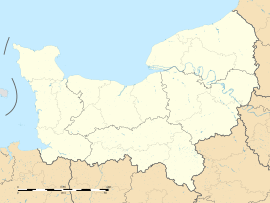Familly facts for kids
Quick facts for kids
Familly
|
|
|---|---|
|
Part of Livarot-Pays-d'Auge
|
|
 |
|
| Country | France |
| Region | Normandy |
| Department | Calvados |
| Arrondissement | Lisieux |
| Canton | Livarot-Pays-d'Auge |
| Commune | Livarot-Pays-d'Auge |
| Area
1
|
10.71 km2 (4.14 sq mi) |
| Population
(2019)
|
116 |
| • Density | 10.83/km2 (28.05/sq mi) |
| Time zone | UTC+01:00 (CET) |
| • Summer (DST) | UTC+02:00 (CEST) |
| Postal code |
14290
|
| Elevation | 165–231 m (541–758 ft) (avg. 178 m or 584 ft) |
| 1 French Land Register data, which excludes lakes, ponds, glaciers > 1 km2 (0.386 sq mi or 247 acres) and river estuaries. | |
Familly is a small village that used to be a separate local area, known as a commune, in northwestern France. It is located in the Calvados department, which is part of the Normandy region.
A commune is like a small town or district that has its own local government. On January 1, 2016, Familly joined with other nearby villages. They all became part of a new, larger commune called Livarot-Pays-d'Auge. So now, Familly is a part of this bigger area.
Understanding Familly's Population
| Historical population | ||
|---|---|---|
| Year | Pop. | ±% |
| 1962 | 153 | — |
| 1968 | 149 | −2.6% |
| 1975 | 112 | −24.8% |
| 1982 | 107 | −4.5% |
| 1990 | 103 | −3.7% |
| 1999 | 98 | −4.9% |
| 2008 | 127 | +29.6% |
The number of people living in a place is called its population. Looking at the population of Familly over the years helps us understand how the village has changed.
From 1962 to 1999, the number of people living in Familly slowly went down. In 1962, there were 153 residents. By 1999, this number had dropped to 98. However, by 2008, the population saw a small increase, reaching 127 people.
A Glimpse into Familly's Past
Familly has a bit of history connected to an important person from the past. The Duke of Monmouth once attended school in this small village.
The Duke of Monmouth was an English nobleman. He was the son of King Charles II of England. His life was quite adventurous and he played a role in English history during the 17th century.
See also
 In Spanish: Familly para niños
In Spanish: Familly para niños



